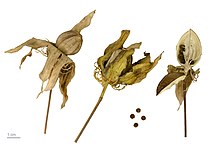Hibiscus coccineus, the scarlet rosemallow,[3] is a hardy Hibiscus species, also known as Texas star, brilliant hibiscus and scarlet hibiscus.
| Hibiscus coccineus | |
|---|---|

| |
| Scientific classification | |
| Kingdom: | Plantae |
| Clade: | Tracheophytes |
| Clade: | Angiosperms |
| Clade: | Eudicots |
| Clade: | Rosids |
| Order: | Malvales |
| Family: | Malvaceae |
| Genus: | Hibiscus |
| Species: | H. coccineus
|
| Binomial name | |
| Hibiscus coccineus | |
| Synonyms[2] | |
| |

The plant is found in swamps, marshes and ditches on the coastal plain of the Southeastern United States.[2] It is native from Southeastern Virginia south to Florida, then west to Louisiana. Despite its common name Texas star, the plant is not found naturally in Texas. In addition to the scarlet-flowering variety, a white-flowering variety is also known as the white Texas star or lone star hibiscus.
Description
editH. coccineus is a herbaceous perennial (it dies back during the winter) and grows 6–8 ft (1.8–2.4 m) tall.[4] The palmately compound leaves are 5–6 in (13–15 cm) wide,[5] and look much like those of the hemp plant, Cannabis sativa. It features bright scarlet flowers that have five petals and are reminiscent of hollyhock.[5] These flowers are attractive to hummingbirds, butterflies and bees, including the specialized bee Ptilothrix bombiformis.[4] The plant prefers to be grown in full sun with moist soil.[6] It is hardy in USDA hardiness zones 6–9.[4]
The Latin specific epithet coccineus means "coloured or dyed scarlet".[7] The genus name is the Greek and Latin name for "mallow".[5]
References
edit- ^ "NatureServe Explorer". Retrieved 2021-02-26.
- ^ a b "Hibiscus coccineus (Scarlet rosemallow)". Lady Bird Johnson Wildflower Center. January 13, 2016. Retrieved February 26, 2021.
- ^ NRCS. "Hibiscus coccineus". PLANTS Database. United States Department of Agriculture (USDA). Retrieved 1 July 2016.
- ^ a b c "Hibiscus coccineus (Red Hibiscus, Scarlet Rose Mallow) | North Carolina Extension Gardener Plant Toolbox". plants.ces.ncsu.edu. Retrieved 2021-02-26.
- ^ a b c "Hibiscus coccineus - Plant Finder". www.missouribotanicalgarden.org. Retrieved 2021-02-26.
- ^ "Hibiscus coccineus". www.tropicalbritain.co.uk. Retrieved 2021-02-26.
- ^ Harrison, Lorraine (2012). RHS Latin for Gardeners. United Kingdom: Mitchell Beazley. ISBN 978-1845337315.
